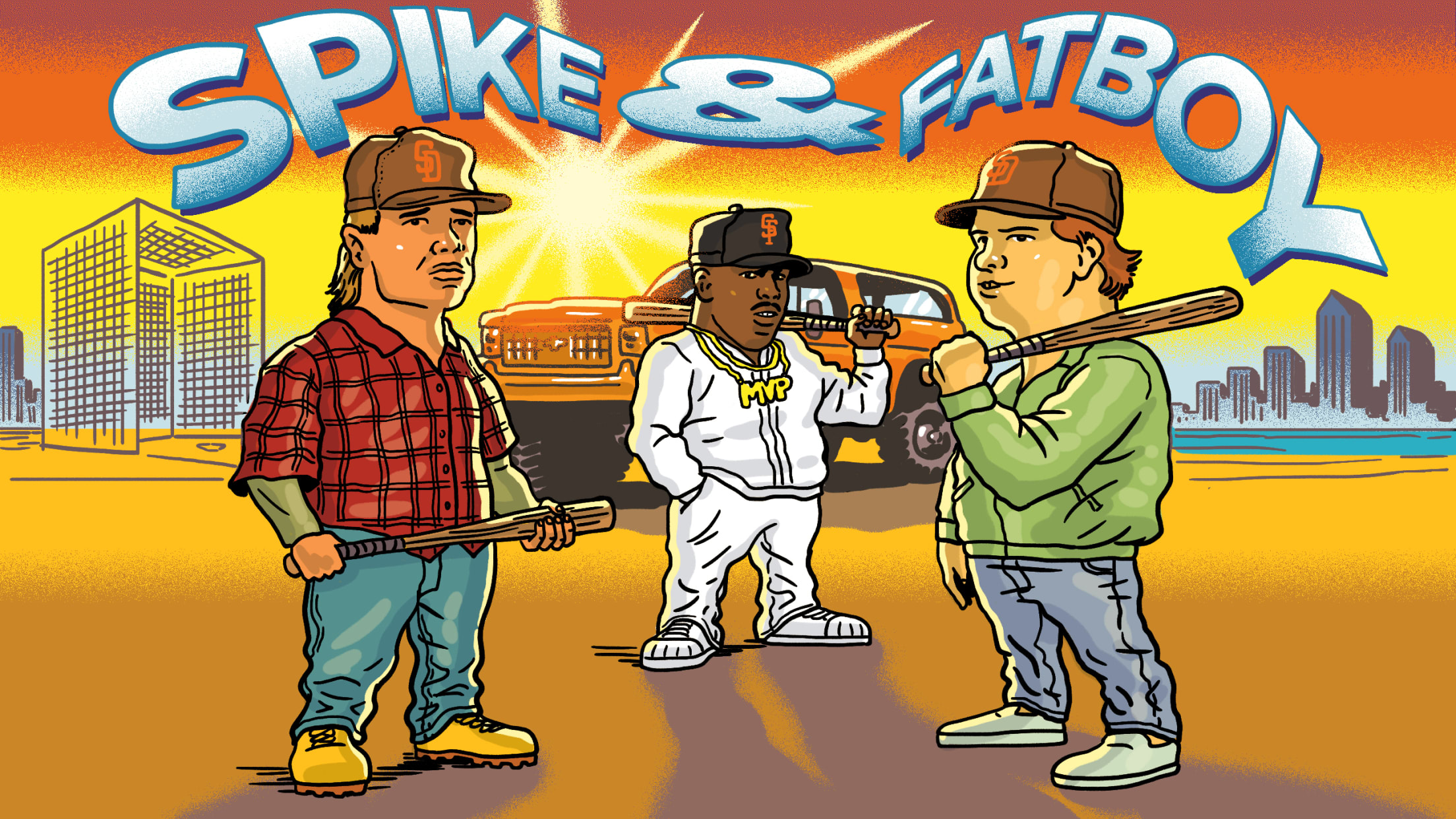
The legend of Spike & Fat Boy: A softball team loaded with MLB ringers

The game was well underway at Ted Williams Field in the North Park neighborhood. It was, it appeared, an ordinary evening in the San Diego City Softball League, with a handful of people in the stands watching grown men perform an athletic activity largely centered on the consumption of beer and pizza.
But then, just as the third inning was about to begin, a Chevrolet K5 Blazer drove up Idaho Street, and heads began to turn.
[Note: A version of this story originally ran on MLB.com in May 2020.]
Pump-up music blared from the open windows as the orange SUV with the words “National League MVP” painted above its wheel wells pulled into the parking lot. Out stepped a 5-foot-10 man wearing a pristine white track suit and gold chains around his neck.
“Time!” called the manager of one of the teams, before making an announcement. “Now replacing Andy Strasberg at third base … Kevin Mitchell!”
On that fall evening in 1989, Mitchell, fresh off the World Series and a Major League-leading 47 home runs and 125 RBIs with the San Francisco Giants, had three at-bats, saw a total of three pitches and hit three long balls, the last of which cleared the left-field fence and two small buildings before landing somewhere on the roof of the North Park Recreation Center.
This might all sound like a booze-fueled fantasy concocted on a creaky barstool … and perhaps some small elements of it are.
But in the late 1980s, on the star-laden squad known as Spike & Fat Boy, active MLB players were known to show up and light up the lobbed balls offered by amateur arms. With the help of three remarkable ringers -- Mitchell, John Kruk and Randy Ready, all of whom would finish their careers with a combined 36 seasons of MLB experience -- this team run by Padres employees brought the big leagues to the beer leagues. America’s Finest City had America’s Finest Softball Team.
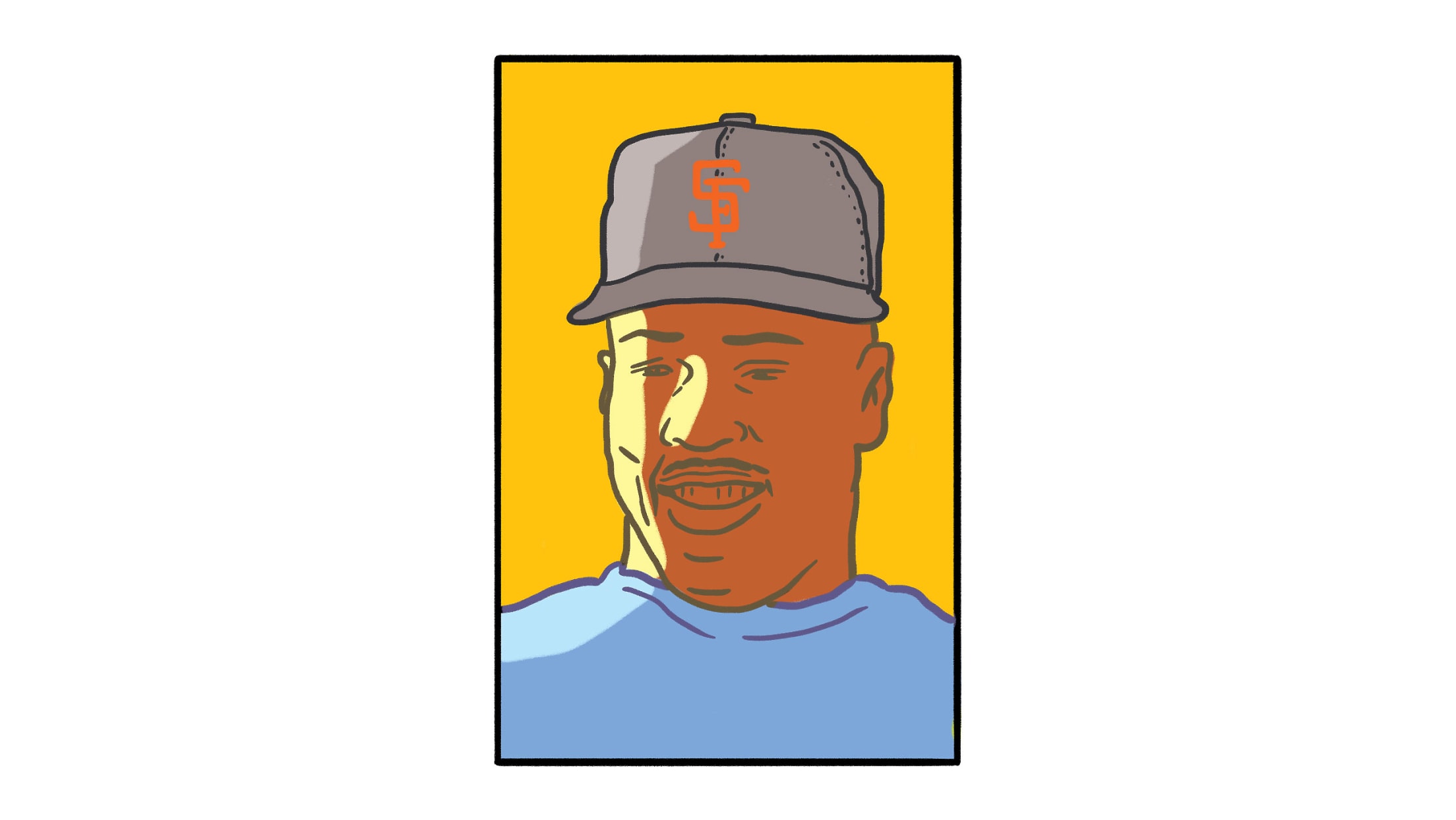
“We were pretty good,” Kruk says slyly.
“We were stacked,” Ready says with a laugh.
“People were in awe when we’d show up,” Mitchell adds.
Forget Montgomery Burns’ All-Star-aided Springfield Nuclear Power Plant squad from that famous 1992 episode of “The Simpsons.” The Spike & Fat Boy team was doing it in real life, a few years earlier.
Now, more than three decades later -- and inspired by a brief mention of the team by Ready in the book “The Wax Pack,” wherein author Brad Balukjian tries to track down all the players from a random pack of 1986 Topps baseball cards -- the story of Spike & Fat Boy can finally be told.
Will some elements of the story be dramatized, magnified, perhaps even fictionalized?
Uh, yeah, probably.
“You have to remember,” says the recently retired Mike Swanson, who, long before assuming his longtime role as the Royals’ vice president of communications and broadcasting, worked in the Padres’ public relations department and played on the team, “there was a lot of drinking.”
Yes, beer leagues tend to involve beer. Combine beer with time, and a lack of record-keeping, and you have a recipe for some, shall we say, embellishment.
People were in awe when we’d show up.
Kevin Mitchell
So let the record show, depending on whose memory you trust from that night in ’89, it’s quite possible Mitchell’s car was actually a just a plain white Mercedes, not the tricked-up Blazer. It’s possible that he had not yet been named the ’89 MVP at the time of the game in question, so no such notation would have been made on his ride. And it’s possible he saw more than three pitches and was wearing more traditional softball garb. Nevertheless, he definitely hit some dingers.
What matters is that the gist of what follows is correct. And that’ll have to be enough, because the legend of Spike & Fat Boy has stayed hidden far too long.
* * * * *
The greatest slow-pitch team you’ve never heard of traces back to 1978. Before then, Padres employees would get together to play softball -- but typically only once a year, in a coed game.
(Incidentally, one of the participants around that time was a young woman named Amanda Sperry, who worked in the team’s ticket office. Not long thereafter, Sperry married her boyfriend, Gary Hamels. And on Dec. 27, 1983, the couple welcomed a son. His name is Cole.)
Two team employees -- Dick Dent, who was the athletic trainer, and the aforementioned Strasberg, who worked in marketing (and is not to be confused with a certain San Diego-born pitcher and World Series MVP with the last name Strasburg) -- wanted something more formal and more frequent. They recruited some coworkers for an entry in a men’s winter league in San Diego, where winter leagues are made possible by the weather ranging anywhere from idyllic to … almost idyllic.
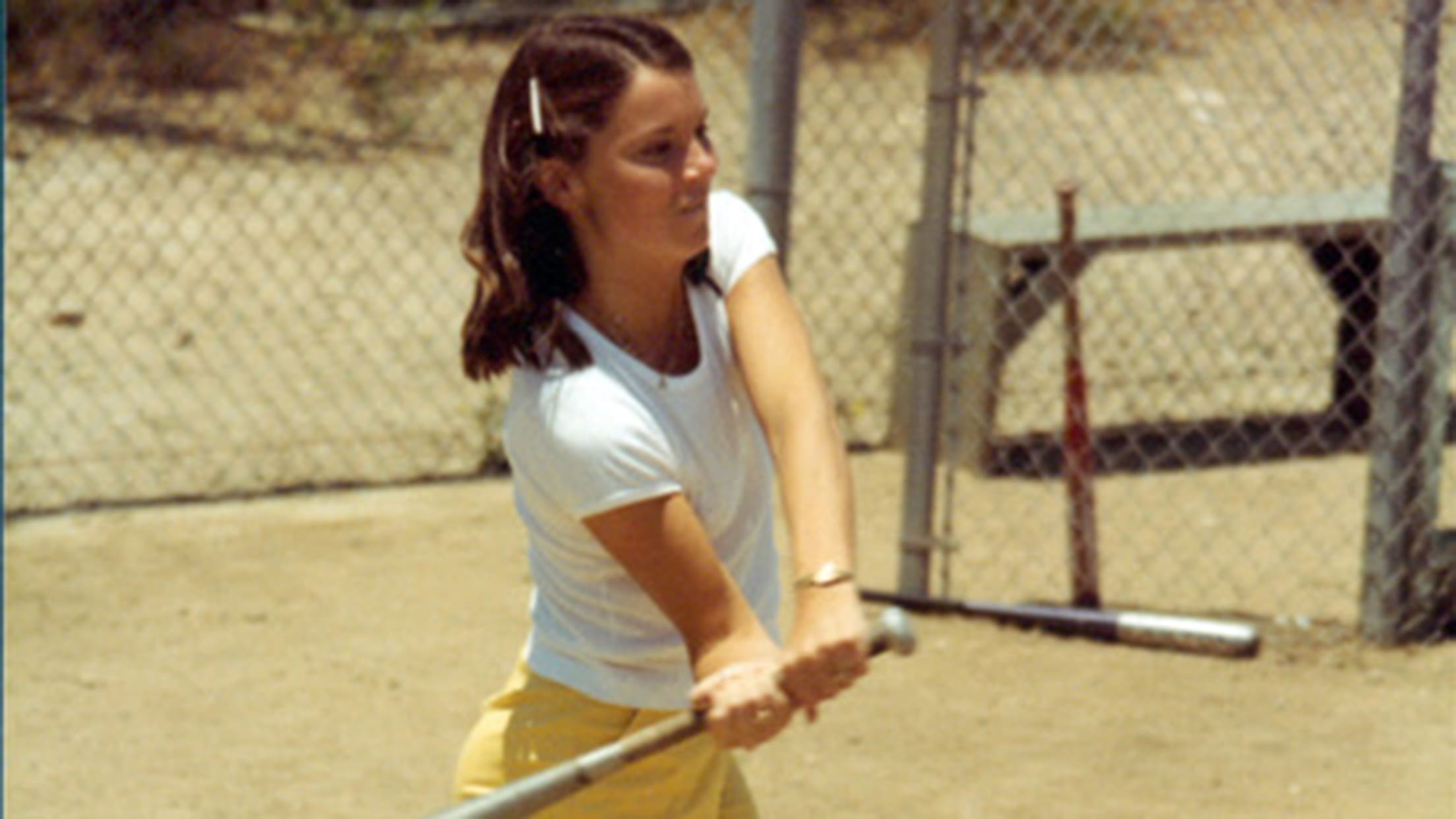
“The folks at the San Diego Recreation Department were great with us,” Strasberg says. “They accommodated our schedule as best they could, knowing [the Padres’] season had to conclude before we could play.”
Padres owner Ray Kroc was accommodating, too. Years earlier he had purchased a Boeing 727 and begun a sports-charter airline business called Padre Air Travel. That company became the softball team’s first sponsor and namesake.
Once the Padre Air Travel team took off, some notable names began to grace the city softball fields.
Nate Colbert, who still holds the Padres’ franchise home run record (163), played with the slow-pitch team in his big league retirement years. Same goes for former MLB pitcher Bo Belinsky and outfielders Bobby Tolan (who coached for the Padres from 1980-83) and Gene Locklear.
The team also included, at various points, general manager (and eventual manager) Jack McKeon, manager Dick Williams, team president Ballard Smith and scouting director (and eventual GM) Randy Smith. The presence of those big shots would create some headaches for longtime Padres broadcaster (and longtime manager of the softball team) Bob Chandler.
“You talk about pressure on a manager,” Chandler says. “What could I do? I had to put those guys in the lineup!”
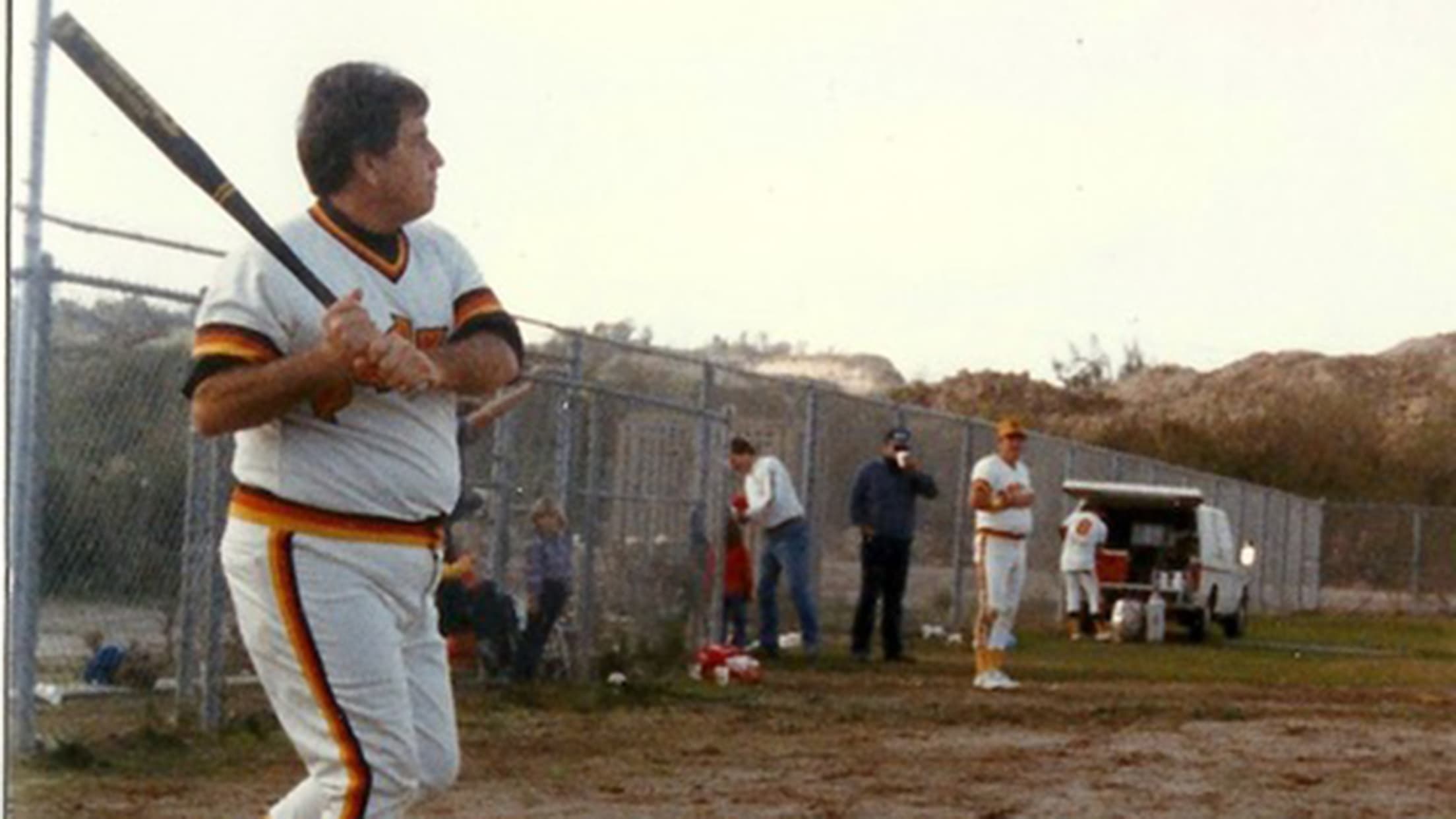
(Chandler, by the way, was the manager who announced Mitchell’s arrival that night in 1989. But subbing out a regular softballer to insert peak-level Kevin Mitchell was not an especially difficult decision.)
Bob Cluck, the eventual big league pitching coach who was the Padres’ farm director in the early 1980s, played on the team, too. Cluck was so sure of his abilities that he declared before one game, “If I don’t get a hit tonight, postgame beers are on me!”
That night, Cluck had already hit four hard liners for outs when he stepped to the plate a final time.
“Here’s our entire dugout, all standing up and cheering for the other pitcher to get him out!” Chandler recalls with a laugh. “And he popped up and sprung for all the beer.”
Mostly, though, the team revolved around lesser-known employees -- trainers, clubhouse attendants, PR people, etc. They’d congregate at local bars Bully’s East or Tuba Man’s Grand Slam before and after games and they’d try to do right by their pitcher and main motivator Dent, a former Army lieutenant and Vietnam veteran who always made sure fundamentals were not lost in all the fun.
“I learned from Dick Williams,” Dent says. “No mental errors. I would never get mad if somebody flubbed the ball. But if they didn’t tag up, that would drive me crazy.”
So one day during the 1987 MLB season, Dent mentioned aloud within the Padres’ clubhouse that the softball team needed a new sponsor.
That’s when Ready’s ears perked up.
On June 13, 1986, Ready, freshly traded from Milwaukee to San Diego, made his Padres debut. That night his then-wife, Dorene, collapsed on the floor of the couple’s home in Tucson. She had suffered a heart attack and was unconscious for seven to 10 minutes, her brain deprived of oxygen for much of that time. The incident permanently hindered her cerebral function.
This is the mental weight Ready was living with away from the field. His profession became his escape, and the versatile infielder and pinch-hitter relished that escape to the tune of a career-best .309 average and .943 OPS in 1987.
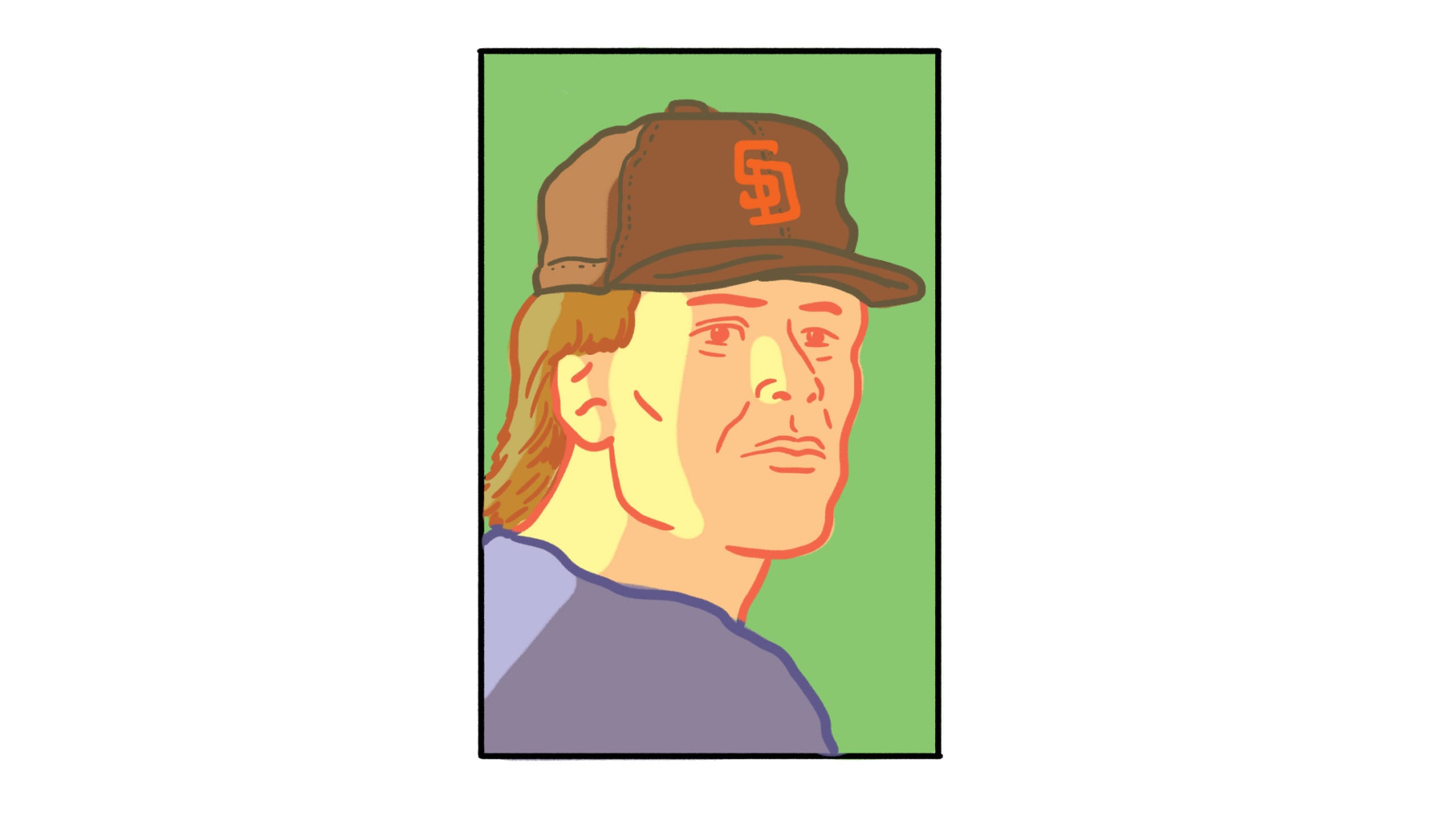
One can understand, then, why Ready would seek any offseason outlet that provided a similarly healthy and helpful diversion. When he found out about the softball team, he wanted in -- not just as a financial backer but as a part-time participant.
“He definitely wanted to have a life outside of baseball and enjoy it,” Swanson says. “And we had a blast with him. He’s one of the coolest dudes I’ve been around in any clubhouse.”
“It was a stress-free environment,” Ready says. “Pizzas, beers and a way to stay in touch with [the Padres’ support staff].”
Looking for a co-sponsor, Ready recruited a Padres teammate who would also be living in San Diego in the offseason. At that time, Kruk was a second-year big leaguer leading the Padres in homers and RBIs. Throughout his terrific career, the joke was that his portly body seemed better suited for beer-league softball than big league baseball.
Little did we know Kruk was playing both.
It was a stress-free environment. Pizzas, beers and a way to stay in touch with [the Padres’ support staff].
Randy Ready
“There was a lot of free time in San Diego for Randy and I back then,” Kruk says. “We figured we’d better do something instead of just basically doing nothing. Softball was the way to go.”
In the Padres’ clubhouse, they referred to Ready as “Spike” because of his spiky hair. They called Kruk “Fat Boy” because, well …
“I think our trainers, Dick Dent and Larry Duensing, came up with that,” Kruk says. “Those geniuses.”
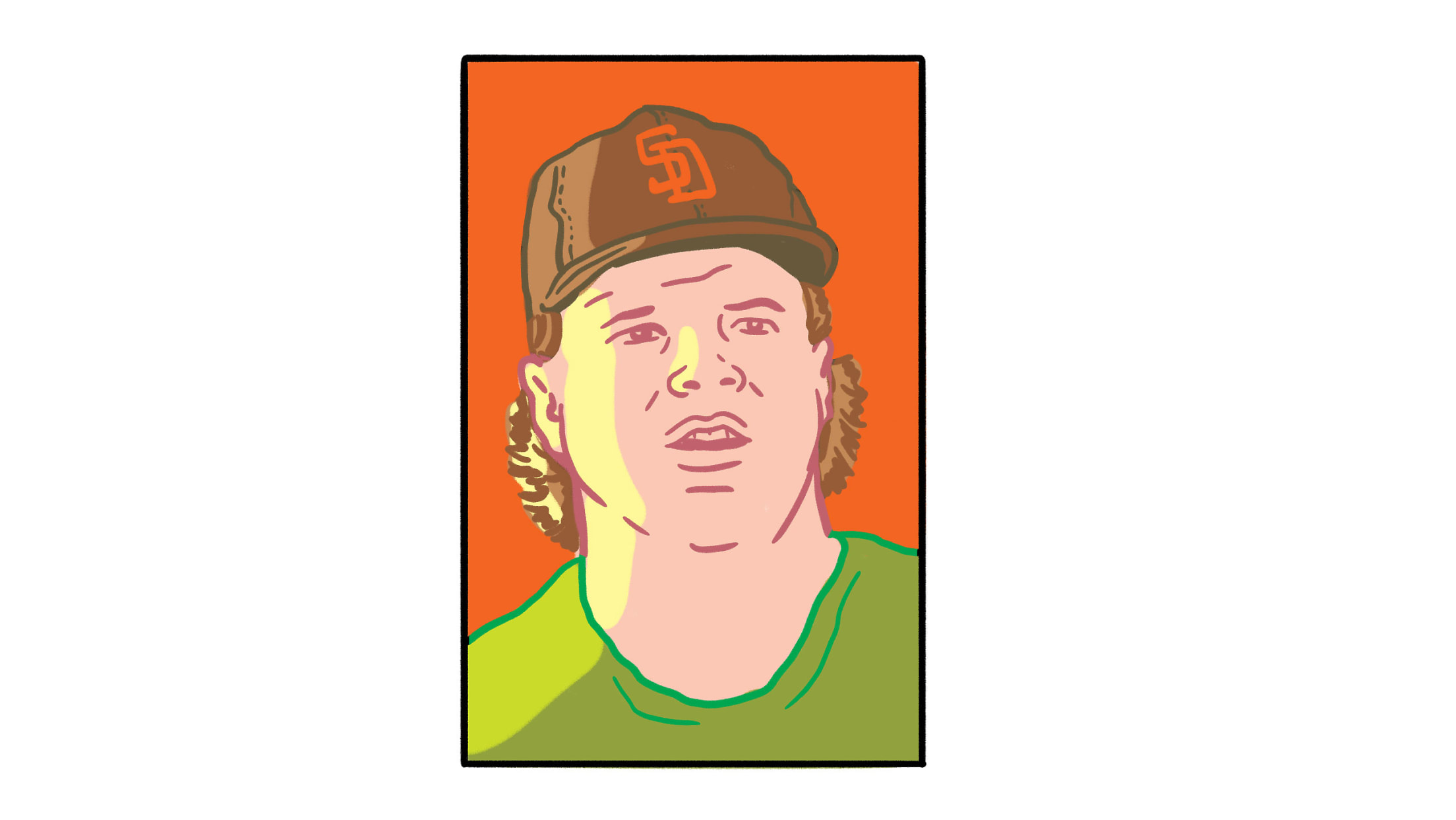
So that’s how Spike & Fat Boy (the team’s official name, though “Spike & The Fat Boys” is an acceptable alternative) came to be.
“One day we said, ‘That’s the perfect name for the softball team!’” Ready recalls. “From a physical standpoint, you can see why it stuck.”
The name stuck for three offseasons -- after the ’87, ’88 and ’89 MLB campaigns. And though Mitchell didn’t last with the Padres nearly as long (he was traded to the Friars from the Mets prior to the ’87 season, only to be shipped off to San Francisco that July), the native and resident San Diegan still got roped into the Spike & Fat Boy scene.
“I got a call from Kruky [with an invite to play],” Mitchell says. “I didn’t believe him at first.”
* * * * *
OK, so how much did these guys really play softball together?
The honest answer is … Who knows?
Kruk, it appears, participated more in the pre- and postgame parties than he did in the actual games. But he did take the field on occasion.
“Because it’s slow-pitch softball, you’re not expected to make an out if you’re a big league player,” he says. “So let’s put it this way: I felt more pressure playing that than I did in baseball. I knew in baseball I’d make an out seven out of 10 times. If I had done that in softball, they’d have killed me.”
“Kruky is the ideal softball player,” Mitchell adds. “He could hit the ball everywhere, no matter who was pitching. That’s how you have to be in softball. If Kruky needed a single, he was going to get a single. He can just flat-out hit.”
Mitchell was definitely on the field that night in ’89 (which we’ll revisit in just a bit), but he claims to have played some in ’87 and ’88, too.
“That’s when we really ramped it up,” Kruk says. “Mitch was so filthy strong.”
What seems certain, based on the conversations for this story, is that Ready was the most active of the active big leaguers involved.
“Randy was funnier than hell,” Swanson says. “When he made an out in softball, you’d have thought the frickin’ world was coming to an end.”
I felt more pressure playing that than I did in baseball. I knew in baseball I’d make an out seven out of 10 times. If I had done that in softball, they’d have killed me.
John Kruk
Ready remembers some nights when his mom, Jeanne, who lived just a couple blocks from the North Park field, was a one-woman cheering section in the stands.
“But then, as word got out, the turnout and our fan base grew,” Ready says. “We always had an entourage, shall we say. And the Madres [a Padres fan organization] caught wind of it and started showing up, too.”
Was Padres management aware of or concerned about the players’ offseason activity?
“Jack McKeon was our GM, so I don’t think he cared,” Swanson says. “That said, I don’t think anybody was running up and down the hallways at the office announcing, ‘We’ve got a big game tonight with Randy and Kruky in it!’”
Did opposing players have a problem getting ambushed by professional ballplayers?
“Nah,” Mitchell says. “Guys couldn’t wait to see us and talk about baseball and talk about the big leagues. That’s what made it so fun. Guys just couldn’t wait to hang out with us.”
Ready recalls a day when Spike & Fat Boy was going to be short a player and needed help. Somebody recommended a Triple-A pitcher in the Padres’ system who was in the area for the winter, rehabbing an injury.
It was the late, great Kevin Towers.
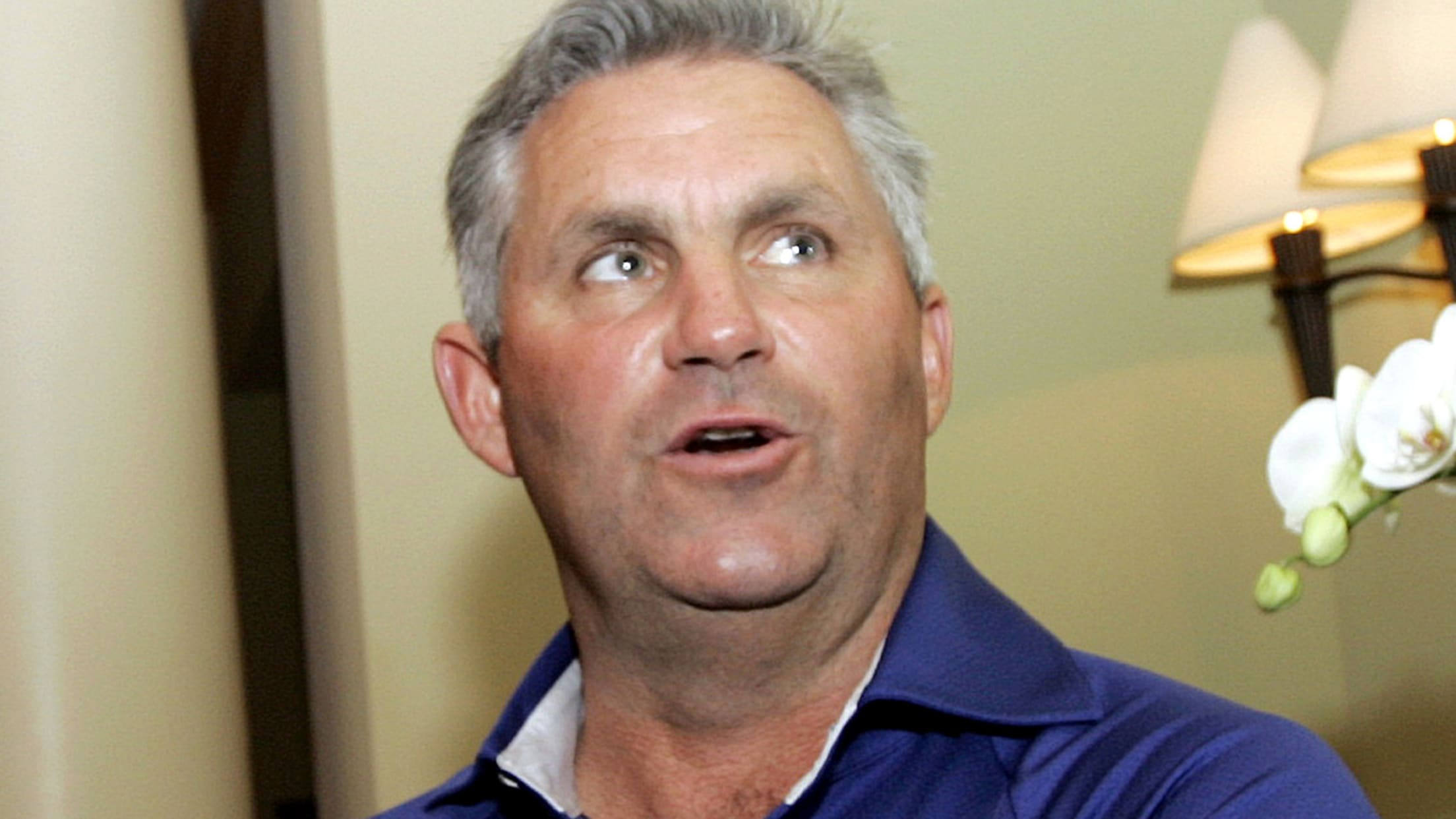
“We put him in right field and batted him ninth,” Ready says with a laugh. “Little did I know he was going to become the gunslinger of GMs.”
One would assume that an amateur softball team featuring Ready and/or Kruk and/or Mitchell, with a little bit of Towers mixed in, wouldn’t lose many games.
Here, too, all we can do is sit back and listen.
Ready: “We didn’t lose a single game. It was domination.”
Swanson: “We’d kick everybody’s ass.”
Kruk: “I don’t recall losing. But my God, that’s so long ago.”
Right, it was so long ago. Before social media. Before we were all walking around with high-resolution cameras in our pockets. If an MLB-boosted softball team existed today, you’d be lucky to get one game in before the interest and attendance became untenable, and you’d have abounding photo and video evidence.
With Spike & Fat Boy, sadly, we had nothing.
That is, until an e-mail arrives from Ready, who rummaged through his home and uncovered buried treasure from the 1988-89 offseason …
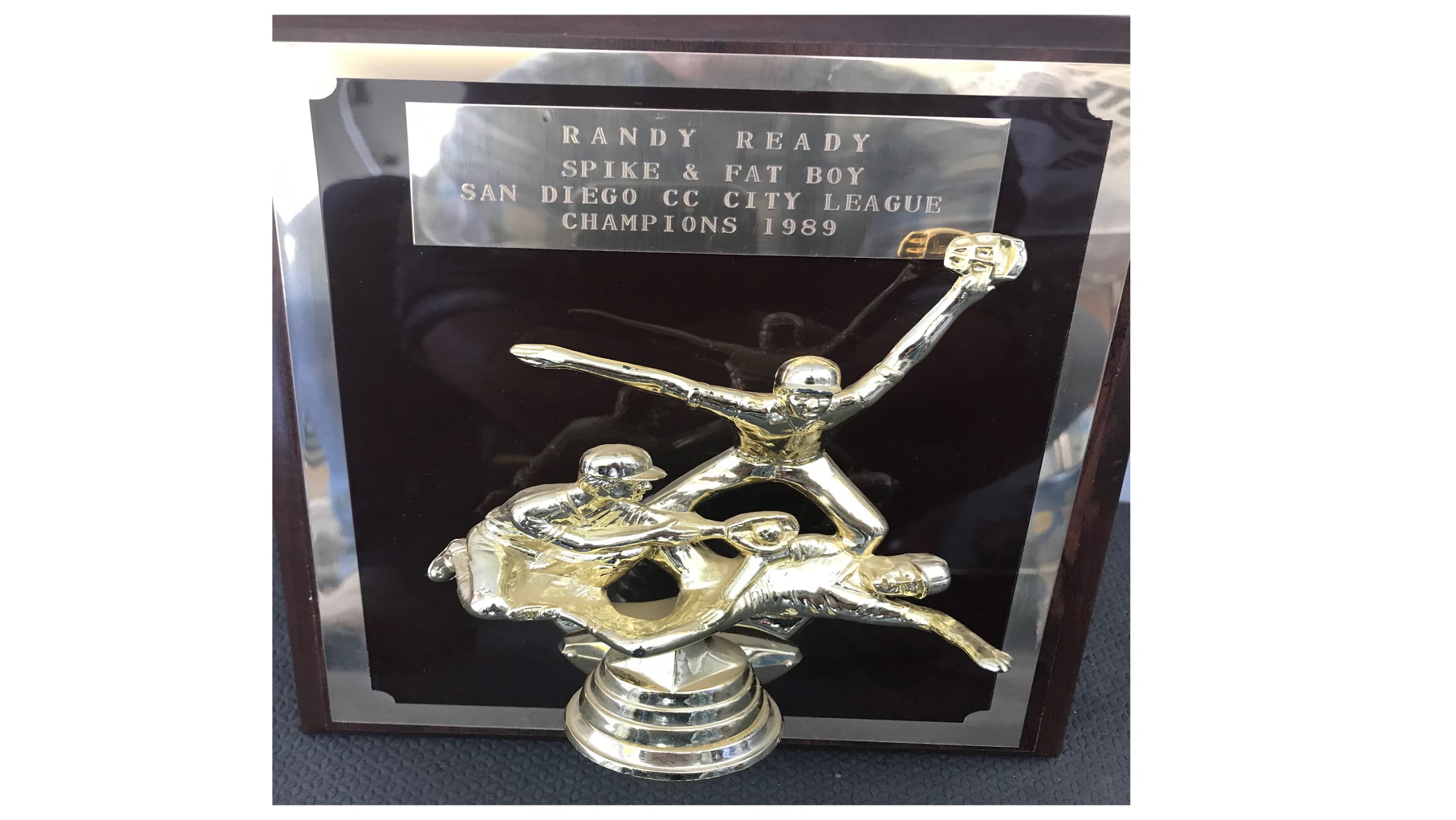
Legendary.
The problem with mixing the beer leagues and the big leagues is that sometimes the latter gets in the way of the former.
On June 2, 1989, the Padres shipped both Kruk and Ready to the Phillies for Chris James. At the time the deal was described in the press as a swap of slumping players (none of the three had gotten off to a good start in ’89), a chance for a reset.
Nobody knew enough to mention the seismic softball implications.
“That’s probably why we got traded,” Kruk jokes. “We were playing softball instead of baseball.”
With the Phillies, Kruk would emerge as a three-time All-Star and one of the faces of the 1993 National League champions. Unfortunately, the swap ultimately severed his ties with Spike & Fat Boy. He was, as Swanson puts it, “a long-distance owner” in ’89, then unaffiliated altogether.
But he still kept playing softball.
“When I was with the Phillies, I used to go back to West Virginia and play in a fall softball league in the offseason with all my buddies I grew up with,” Kruk says. “I’d miss part of the season, because they would start in September. And then the one year we were in the World Series, the guys didn’t care that I wasn’t there, because they were so happy for me.”
As for the remaining members of Spike & Fat Boy, they kept the team going for another few seasons. Ready still hung around the area and showed up in the winter after the trade.
In 1990 the team became known as “Ripper’s Derelicts” after Padres first baseman Jack “The Ripper” Clark assumed the sponsorship duties (in a non-playing role). Alas, that was also the year of a Padres ownership change, which led to various staffing changes. Dent was one of the casualties, and the softball team fizzled out not long thereafter.
So the Ready-Kruk-Mitchell era will go down as the peak of Padres employee softball prowess. It doesn’t get any better than that.
Or does it?
“Nobody’s mentioned Robbie Alomar?” Swanson asks.
Wait … what?!
“Oh yeah, Robbie played,” Swanson adds. “It might have been after we traded Randy. Robbie ended up hanging out one winter and came to a couple games and played. You know, just a [future] Hall of Famer. No big deal.”

Unfortunately, when reached for this story, Alomar said he has no recollection of this. But look, do you remember everything you did in, say, 1989 or 1990? Nah, of course not. So let's leave the window cracked open just enough for a whiff of pure possibility to waft in. After all, in the ethereal and largely undocumented world of Spike & Fat Boy, who's to say what is fact and what is fiction?
What we can say is that too many people interviewed for this story brought up, without any prodding, their memory of Mitchell’s three-homer night in ’89 for it not to have happened.
Dent: “It was like Rodney Dangerfield pulling up [in “Caddyshack”]. He had lights on his wheels and stuff like that. He came in, and Andy gave him his position at third.”
Strasberg: “I said to the four or five people in the stands, ‘I don’t know where they got this stiff from!’”
Swanson: “I had gotten a hit and moved over to third base, so I’m 60 feet from freaking Kevin Mitchell with an aluminum bat in his hand. The ball came off the bat, and I thought I was going to have a coronary.”
Ready: “Mitch back-legged a softball and sent it over the roof!”
Chandler: “That’s the longest home run I’ve ever seen in softball. That was the field where Ted Williams played as a kid, and I’m not sure Williams ever hit one farther than Kevin Mitchell did.”
Presented with these memories, Mitchell gets wistful. After his retirement, he played in another San Diego adult softball league, on a team called the Black Sox. But he had to give that up a few years back, when he had a major health scare -- a bulging disc in his neck that pressed against his spinal cord and affected his ability to move.
Though he still has some trouble with his right leg, which requires physical therapy, Mitchell is feeling much better now. He’s got his weight and his spirits back. And all this talk about the old days had him pondering the possibilities for the former members of Spike & Fat Boy.
“Give Kruky my number,” he says. “Let’s bring it back!”